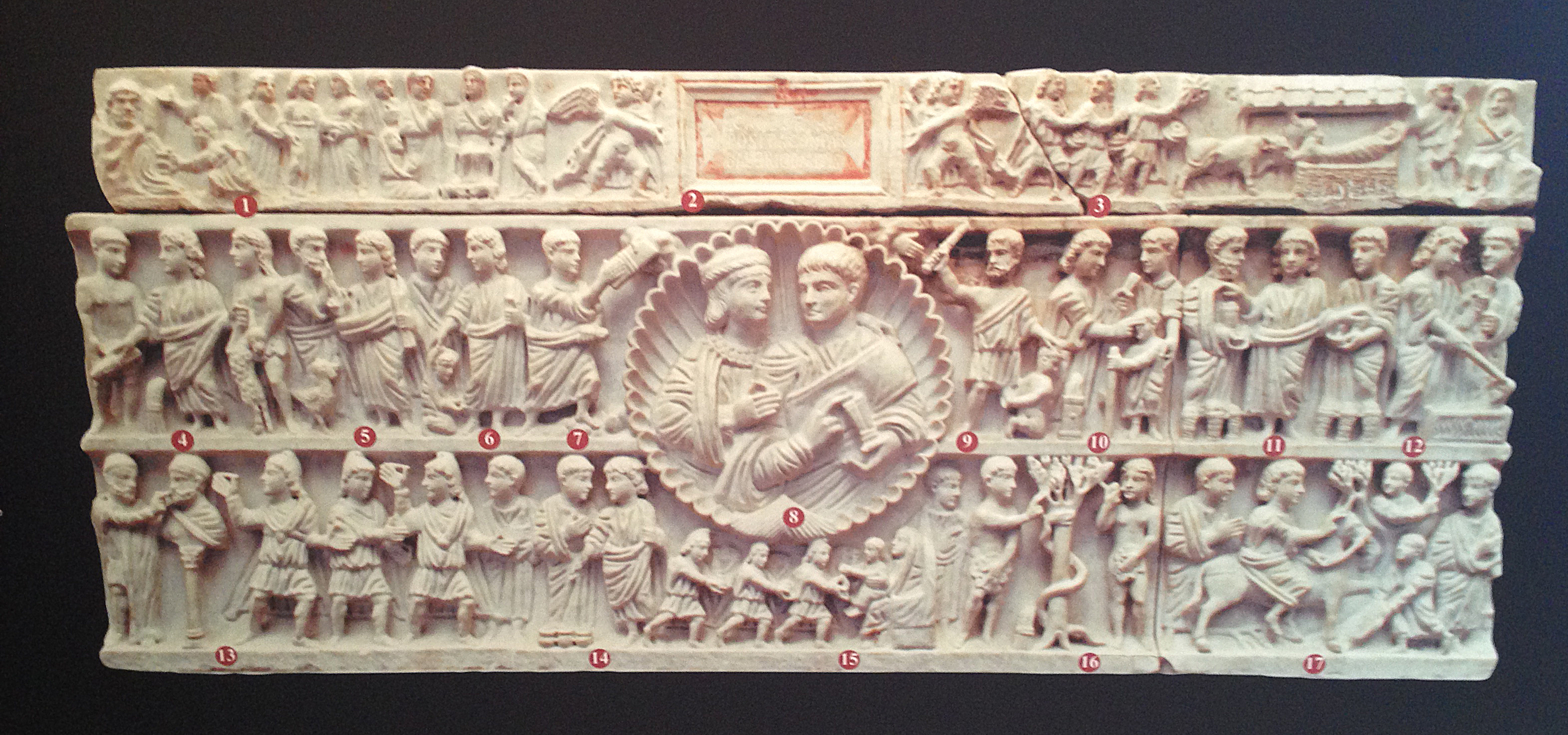Sarcophagus Of Adelphia on:
[Wikipedia]
[Google]
[Amazon]
 The Sarcophagus of Adelphia is an
The Sarcophagus of Adelphia is an
 The name of the sarcophagus derives from the hypothesis that it was used for the burial of the Roman noblewoman Adelfia. The central medallion would represent a portrait of the couple, mentioned in the center of the lid by an epigraph arranged on three lines in a
The name of the sarcophagus derives from the hypothesis that it was used for the burial of the Roman noblewoman Adelfia. The central medallion would represent a portrait of the couple, mentioned in the center of the lid by an epigraph arranged on three lines in a Christian iconography
website. The scenes are depicted in a high bas relief. The scenes do not follow a timeline, and can be poorly distinct from one another. In the upper lid are likely four episodes, two likely regarding the life of Mary on the left, and two depicting events surrounding the Nativity, including the three Magi following the star of Bethlehem. It also contains a plaque identifying Adelphia and her spouse Valerius. The second register has eight episodes, four on each side of the central shell with the married couple. On the left, from left to right, are scenes depicting: *Work imposed on Adam and Eve * Denial of Peter with the cockerel *Jesus healing the bleeding woman *Moses receives tablets On the right are scenes depicting *Abraham and Isaac *Christ heals the blind *Miracle of Multiplication of the loaves *Raising of the son of the widow of Nain In the third (lowest) register, are scenes depicting: * Shadrach, Meshach, and Abednego refuse pagan worship *Miracle at the Marriage at Cana * Adoration of the Magi *Adam, Eve, and the Serpent in the Tree of the Knowledge of Good and Evil *Jesus enters Jerusalem
early Christian
Early Christianity (up to the First Council of Nicaea in 325) spread from the Levant, across the Roman Empire, and beyond. Originally, this progression was closely connected to already established Jewish centers in the Holy Land and the Jewish d ...
, circa 340 AD sarcophagus
A sarcophagus (plural sarcophagi or sarcophaguses) is a box-like funeral receptacle for a corpse, most commonly carved in stone, and usually displayed above ground, though it may also be buried. The word ''sarcophagus'' comes from the Greek ...
now in the Museo Archeologico Regionale Paolo Orsi
The Museo Archeologico Regionale Paolo Orsi of Syracuse, Sicily is one of the principal archaeological museums of Europe.
History
In 1780 the Bishop Alagona inaugurated the ''Museo del Seminario'' which became the ''Museo Civico'' near the arch ...
in Syracuse, region of Sicily, Italy. The sarcophagus was found in the Rotunda of Adelphia inside the Catacombs of San Giovanni, in Siracusa. The iconography displayed has similarities to the layout of the Dogmatic and Junius Bassus sarcophagi, although the quality of to depictions is simplified.
Description
tabula ansata
A tabula ansata or tabella ansata (Latin for "tablet with handles", plural ''tabulae ansatae'' or ''tabellae ansatae'') is a tablet with dovetail handles. It was a favorite form for votive tablets in Imperial Rome.
Overview
''Tabulae ansatae' ...
on a red background:
(H)IC ADELFIA C(LARISSIMA) F(EMINA)
POSITA CONPAR
BALERI COMITIS
''Here lies Adelphia, famous woman, wife of Count Valerius''.
The front side of the marble sarcophagus is split into two registers, typical of the style of the time, with both Old Testament
The Old Testament (often abbreviated OT) is the first division of the Christian biblical canon, which is based primarily upon the 24 books of the Hebrew Bible or Tanakh, a collection of ancient religious Hebrew writings by the Israelites. The ...
and New Testament subjects and a central shell-shaped '' clipeus'' containing the portraits of the dead couple, embracing. The lid of the sarcophagus forms a third register. Of note, the depictions of Moses and Jesus, and perhaps God in Eden, are unbearded, as opposed to the bearded Abraham.website. The scenes are depicted in a high bas relief. The scenes do not follow a timeline, and can be poorly distinct from one another. In the upper lid are likely four episodes, two likely regarding the life of Mary on the left, and two depicting events surrounding the Nativity, including the three Magi following the star of Bethlehem. It also contains a plaque identifying Adelphia and her spouse Valerius. The second register has eight episodes, four on each side of the central shell with the married couple. On the left, from left to right, are scenes depicting: *Work imposed on Adam and Eve * Denial of Peter with the cockerel *Jesus healing the bleeding woman *Moses receives tablets On the right are scenes depicting *Abraham and Isaac *Christ heals the blind *Miracle of Multiplication of the loaves *Raising of the son of the widow of Nain In the third (lowest) register, are scenes depicting: * Shadrach, Meshach, and Abednego refuse pagan worship *Miracle at the Marriage at Cana * Adoration of the Magi *Adam, Eve, and the Serpent in the Tree of the Knowledge of Good and Evil *Jesus enters Jerusalem
References
{{reflist Adelphia Statues of Jesus 4th-century Roman sculptures Christian iconography Early Christian art Cultural depictions of Adam and Eve Adoration of the Magi in art Saint Peter